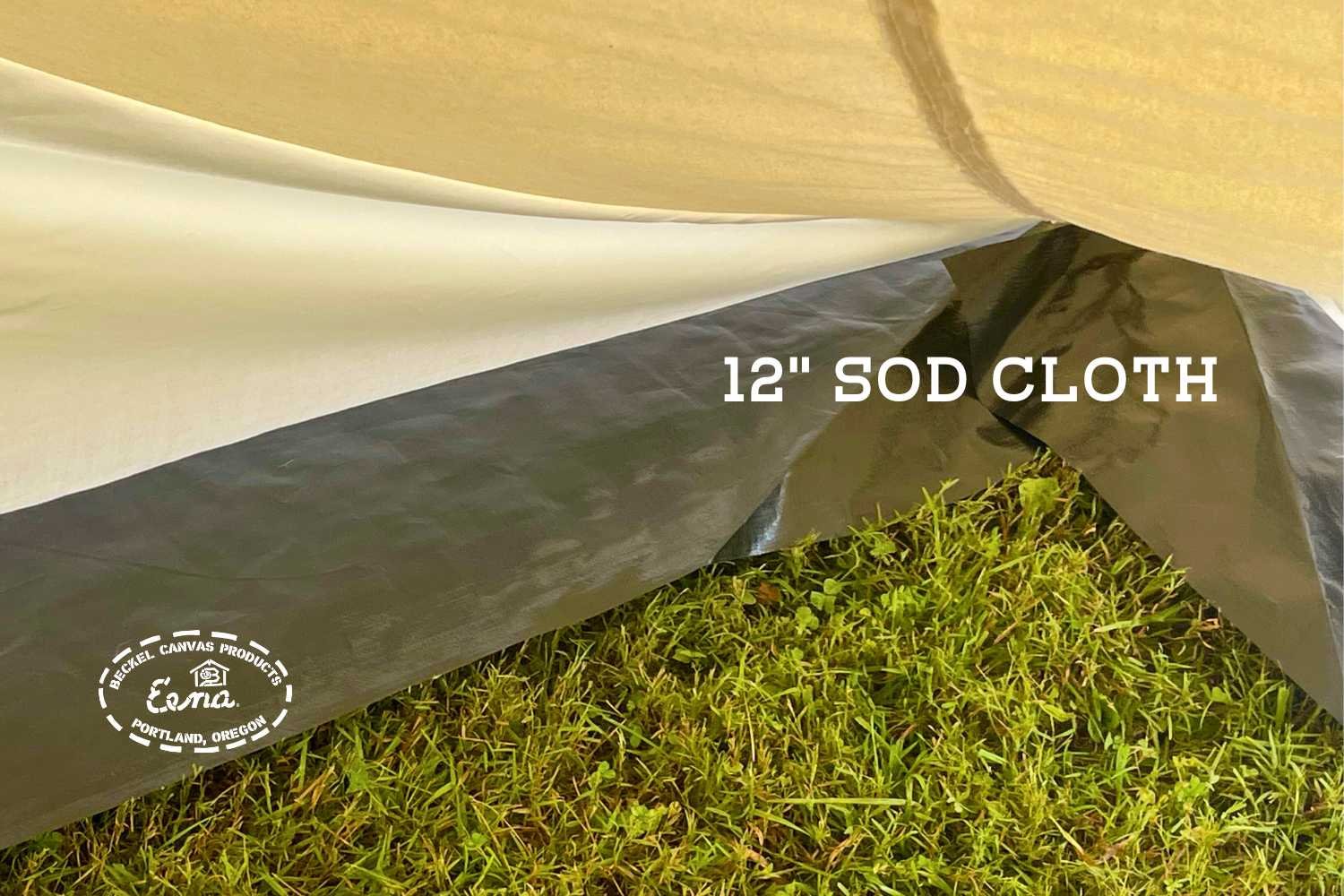What Is the Sod Cloth on a Wall Tent?
If you’re considering buying a canvas wall tent, you’re probably analyzing all the features, materials, parts, and accessories that come standard (or as add-ons). And one such wall tent option is the sod cloth. “Sod cloth?” you might ask. “What’s that?”
What Is a Sod Cloth?
Sod cloth is a wide fabric band sewn along the bottom walls and perimeter of your tent that helps to create a barrier and seal against the ground - helping to create a weather-seal and critter deterrent. The fabric of sod cloth roughly 12-inches wide, depending on the wall tent manufacturer. Sometimes, you will find wall tents that offer longer, extended walls that can be folded under, which also act as a sod cloth.
Sod cloths are typically made of more durable man-made materials like heavy, UV-resistant, and weatherproof vinyl or poly, making it easy to wipe down and clean. Sod cloth can also be made of canvas, though poly or vinly is more common these days because it it more resistant to mold and mildew.
When exploring wall tent brands, you’ll find that most wall tents do not have a floor sewn into them. This is a common trait, allowing outfitters and hunters to choose the most suitable flooring type and configuration for their tent that can be laid over the sod cloth.
Also, while sod cloths are associated with wall tents, some A-frame style tents come with a sod cloth as well.
Two perfect examples are Beckel’s Miner Tent and TT Pyramid Tent.
In short: a sod cloth is a mud flap-like seal that keeps the elements out and warmth in.
If you’re looking at a wall tent, pyramid tent, or A-frame style tent by Beckel Canvas, here’s what kind of sod cloth you’ll find:
12-inch wide band
Made of 7 oz. poly
What Does a Sod Cloth Do?
The sod cloth of a wall tent has a simple function: to create a barrier that prevents things from entering your tent. Snow, rain, mud, critters, bears, spiders, snakes, you name it!
Due to the rugged, practical nature of wall tents, they became the shelter of choice for outfitters and hunters, and the sod cloth also became a built-in feature to take on such harsh environments of the backcountry wilderness.
A sod cloth keeps out wind, heavy snow, rain downpours, and more. The sod cloth also does a good job of keeping pests and critters from making their way inside, whether in search of food or to keep warm.
How to Use a Sod Cloth Properly
As you can see, sod cloths have an extremely important purpose on your wall tent. Failure to use a sod cloth correctly could have a negative impact on your wall tent setup, resulting in… well, just a plain uncomfortable camping experience.
Fold the Sod Cloth Inside the Tent
First, you need to understand that sod cloths are intended to be folded inside the tent. They’re much more effective that way. Rarely will you see otherwise or have reason to fold it outward. In fact, folding sod cloth outside could catch rain and snow melt, channeling it into the tent – and you don’t want that!
Case in point: Well, folding your sod inside (where the tent is warmer) also helps to prevent that frozen-stuck situation.
Secure the Sod Cloth With Flooring
The sod cloth folds inside the tent – once your wall tent is set-up. Portions of it will be under your leg poles. At this point, you then roll out and place your wall tent flooring (detached or loose style wall tent floor options) over the sod cloth. Once you have your tent flooring aligned along the wide sod cloth band, secure both with the tent poles.
If you don’t have a floor, then you can get creative and weigh down the sod cloth with dirt, logs or other camping supplies that you have with.
HISTORY OF SOD CLOTH
Traditionally, “sod cloth” was quite a literal term. You would place a mound of sod (or straw) on top of the sod cloth flap. Today, that method is no longer used or even recommended. At best, some outfitters still dig a trench along the outside or their wall tents, to funnel away water from rain and snow melts, but it doesn’t involve the sod cloth.
And sure, if you want to create an accurate wall tent setup for historical reenactments, by all means, go ahead! But it’s not necessary.
Simply put – there are far better, hassle-free, less messy options.
The only exception is if you are camping in extreme weather conditions. But even then, true outfitters and mountaineers recommend taking it a step further by burying the sod cloth to ensure the tent withstands blizzard-like conditions.
Extra Tip 1: You can double up your flooring by using both a tarp footprint and detached or loose tent flooring. This setup involves three layers: the footprint tarp against the earth, the sod cloth over that, then the detached floor, all held in place by the internal tent poles.
Extra Tip 2: If you want extra wind security, you can place other gear or items on top of the sod cloth. Items such as firewood (which you’ll most likely have for your wood stove) or legs of cots and tables. Rocks are a solid choice too!
Conclusion
So there you have it! The “sod cloth” simplified. Now you know what to do with it when you go to set up your wall tent.
Learning how to set up a wall tent the first time takes some effort. Practice it a few times in your backyard, if you can, so you can set up in the backcountry quickly without wasting valuable hours you would use exploring or hunting.

